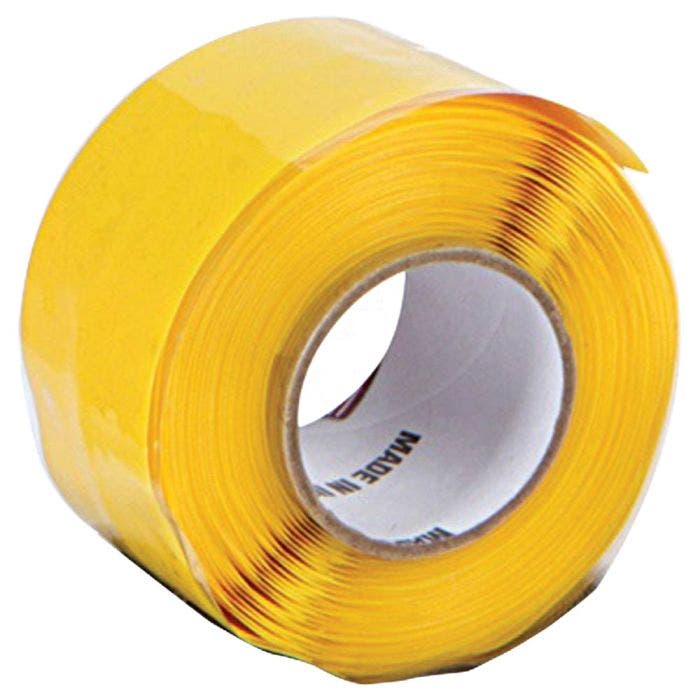Self Fusing Silicone Tape Yellow by A.M. Leonard
In stock
SKU
A24129
$7.85
SEE ALL TIER PRICING
Buy 3 for $7.60 each and save 3%Buy 6 for $7.35 each and save 6%
READ MORE...
Product Information
Product Specs
- Color: Yellow
- Width: 1 inch
- Thickness: 20 mils
- Length: 10 feet per roll
- Bonding: Binds to itself, not to substrate
- Sealing: Creates an airtight and waterproof seal
- Insulation: Insulates up to 400 volts per mil
- Resistance: Resists UV, oil, salt, and chemical based degradation
- Temperature Resistance: Survives extreme temperatures from 65*F to 500*F
- Stretch: Stretches more than 300%
- Shape Conformity: Forms around irregular shapes and fittings
- Bonding Time: Bonds into a solid layer within seconds
- Removability: Can be easily removed with a knife without leaving messy residue
- Origin: Made in the USA
- Warranty: Backed by a lifetime warranty
Product Warranty Information
- This product is covered by A.M. Leonard's Down-to-Earth guarantee. Click here for more details.
Product Features
- Leonard Self Fusing Silicone Tape Yellow
- Perfect for even the most extreme environments!
- Features a unique triangular profile
- Bonds to itself to create an airtight and waterproof seal
- Measures 1 inch in width and 20 mils in thickness
- Insulates up to 400 volts per mil and resists UV, oil, salt, and chemical based degradation
- Survives extreme temperature fluctuations from 65*F to 500*F and stretches more than 300%
- Designed to last and easy to remove without leaving any messy residue
- Uses are limitless - color code tools, fix damaged irrigation lines, protect electrical connections, repair machinery, and more
- Sold in 10 foot rolls
- Made in the USA and backed by our lifetime warranty!
Product Shipping Weight
- .1 pounds
Frequently Asked Questions
What are some tips for designing a small garden space?
Some tips for designing a small garden space include using vertical space, incorporating containers and raised beds, selecting plants that are proportionate to the size of the space, and utilizing multi-functional garden features.
What type of soil is best for growing vegetables?
The best type of soil for growing vegetables is loamy soil, which is a combination of sand, silt, and clay. This type of soil allows for proper drainage and aeration while retaining moisture and nutrients for plant growth.
How can I maintain a healthy lawn?
To maintain a healthy lawn, it is important to mow regularly, remove weeds and debris, water deeply and infrequently, fertilize appropriately, and aerate the soil to promote root growth.
What is the best way to control pests in my garden without using harmful chemicals?
The best way to control pests in your garden without using harmful chemicals is to encourage natural predators, such as ladybugs and lacewings, to feed on harmful insects. You can also use companion planting, which involves planting certain plants together to deter pests, and practicing good garden hygiene by removing plant debris and maintaining proper watering and fertilization practices.
Some tips for designing a small garden space include using vertical space, incorporating containers and raised beds, selecting plants that are proportionate to the size of the space, and utilizing multi-functional garden features.
What type of soil is best for growing vegetables?
The best type of soil for growing vegetables is loamy soil, which is a combination of sand, silt, and clay. This type of soil allows for proper drainage and aeration while retaining moisture and nutrients for plant growth.
How can I maintain a healthy lawn?
To maintain a healthy lawn, it is important to mow regularly, remove weeds and debris, water deeply and infrequently, fertilize appropriately, and aerate the soil to promote root growth.
What is the best way to control pests in my garden without using harmful chemicals?
The best way to control pests in your garden without using harmful chemicals is to encourage natural predators, such as ladybugs and lacewings, to feed on harmful insects. You can also use companion planting, which involves planting certain plants together to deter pests, and practicing good garden hygiene by removing plant debris and maintaining proper watering and fertilization practices.
Write Your Own Review


